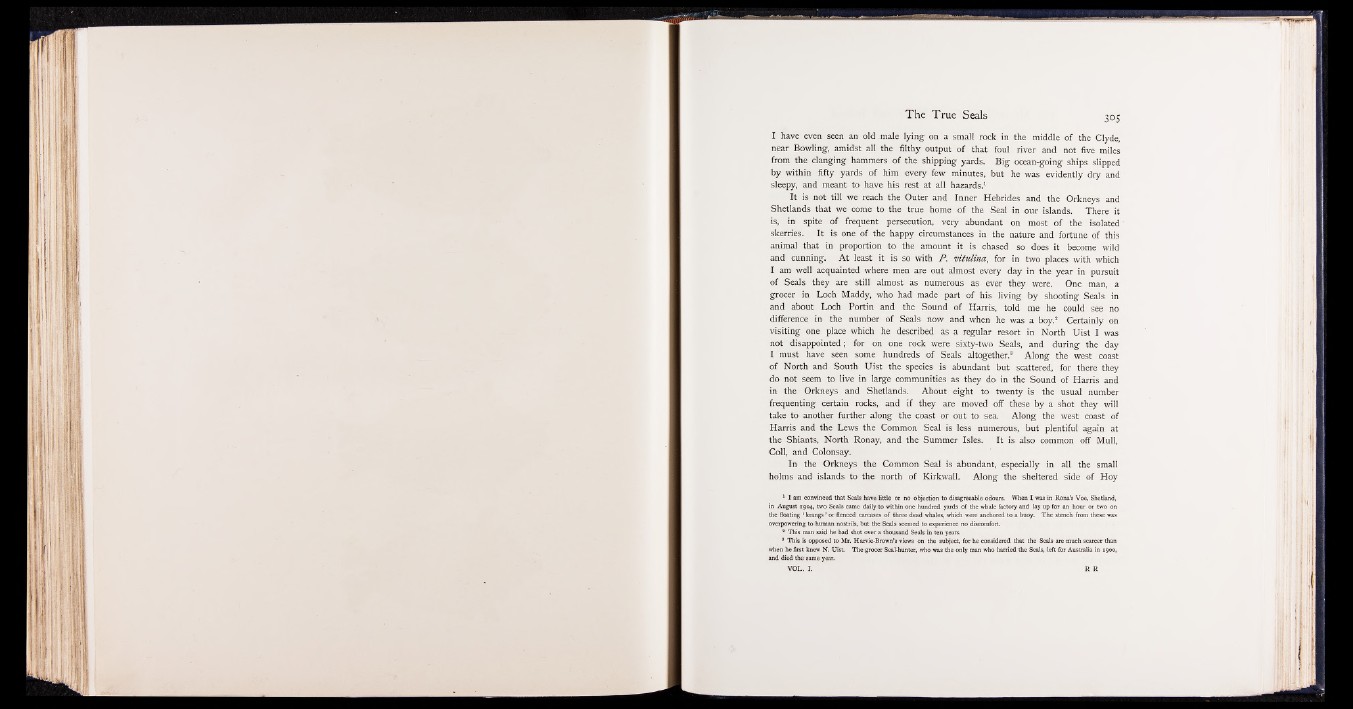
I have even seen an old male lying on a small rock in the middle of the Clyde,
near Bowling, amidst all the filthy output of that foul river and not five miles
from the clanging hammers of the shipping yards. Big ocean-going ships slipped
by within fifty yards of him every few minutes, but he was evidently dry and
sleepy, and meant to have his rest at all hazards.1
It is not till we reach the Outer and Inner Hebrides and the Orkneys and
Shetlands that we come to the true home of the Seal in our islands. There it
is, in spite of frequent persecution, very abundant on most of the isolated
skerries. It is one of the happy circumstances in the nature and fortune of this
animal that in proportion to the amount it is chased so does it become wild
and cunning. At least it is so with P. vitulina, for in two places with which
I am well acquainted where men are out almost every day in the year in pursuit
of Seals they are still almost as numerous as ever they were. One man, a
grocer in Loch Maddy, who had made part of his living by shooting Seals in
and about Loch Portin and the Sound of Harris, told me he could see no
difference in the number of Seals now and when he was a boy.2 Certainly on
visiting one place which he described as a regular resort in North Uist I was
not disappointed; for on one rock were sixty-two Seals, and during the day
I must have seen some hundreds of Seals altogether.8 Along the west coast
of North and South Uist the species is abundant but scattered, for there they
do not seem to live in large communities as they do in the Sound of Harris and
in the Orkneys and Shetlands. About eight to twenty is the usual number
frequenting certain rocks, and if they are moved off these by a shot they will
take to another further along the coast or out to sea. Along the west coast of
Harris and the Lews the Common Seal is less numerous, but plentiful again at
the Shiants, North Ronay, and the Summer Isles. It is also common off Mull,
Coll, and Colonsay.
In the Orkneys the Common Seal is abundant, especially in all the small
holms and islands to the north of Kirkwall. Along the sheltered side of Hoy
1 I am convinced that Seals have little or no objection to disagreeable odours. When I was in Rona's Voe, Shetland,
in August 1904, two Seals came daily to within one hundred yards of the whale factory and lay up for an hour or two on
the floating ‘ krangs ’ or flenced carcases of three dead whales, which were anchored to a buoy. The stench from these was
overpowering to human nostrils, but the Seals seemed to experience no discomfort.
* This man said he had shot over a thousand Seals in ten years.
8 This is opposed to Mr. Harvie-Brown’s views on the subject, for he considered that the Seals are much scarcer than
when he first knew N. Uist. The grocer Seal-hunter, who was the only man who harried the Seals, left for Australia in 1900,
and died the same year.
VOL. I. R R